IMPROVE YOUR SKILLS
Informative articles to help you better understand and utilize the Tools of the
Trade
"Back to Basic's" Vol.
1
Choosing the correct line to get the job done
This
month's "Back to Basic's" will
help you understand and determine which type of fishing line to spool
up for your next outing. These are general guidelines that I use
to help me perform better and catch more fish.
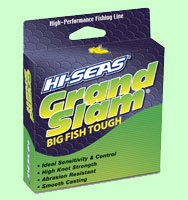 MONOFILAMENT
LINE:
MONOFILAMENT
LINE:
In general, monofilament lines have a larger line diameter than other
types of lines. Yet, they are less dense than most other types of line.
Due to the larger diameter and lower density, this type of line will
sink at a slower rate that makes it an excellent choice for fishing
top-water baits. The larger diameter will also help sinking baits stay
higher in the water column such as burning spinnerbaits and Rattle
Baits. The larger diameter increases the visibility under the water
so it's best used in stained to muddy water conditions. These types
of lines also have a higher stretch than most other types of line.
Keep this in mind when making your rod selection. You will find that
a faster action rod will help with the line stretch. Monofilament lines
are also the friendliest types of line for using a variety of knot
types.
Rick's Applications:
- Main line for Carolina Rig's - 15 or 20 pound test Hi-Seas Grand
Slam
- Preferred for Top-Water applications - 15, 20, or 25 pound test
Hi-Seas Grand Slam
- Low water visibility - stained to muddy
Rick's Reminders:
- Higher visibility - best suited for stained to muddy water conditions
- Slower sink rate - top-water applications
- More stretch - less sensitive, requires more aggressive hook set
on longer casts
- Rod action - a faster tip rod will help pick up the stretch
- Retains memory - monofilaments need to be changed out frequently
due to memory (line curling)
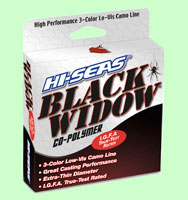 CO-POLYMER
LINE:
CO-POLYMER
LINE:
Co-Polymers are blended from different polymer lines that close the
gap between monfilament and braided lines. Typically, they have a smaller
line diameter and greater density than monofilament and braid. They
also stretch less than monofilaments and increase your casting distance.
Although they have a higher density, they still perform well with most
top-water applications. Due to the lower line stretch, a rod with a
more limber action works well with larger baits that give the fish
leverage when fighting. The reduced line diameter decrease's the visibility
under water so it can be used in clearer water condition's, it allows
baits to go deeper, or it allows you to increase the pound test to
fish heavier cover.
Rick's Applications:
- Crankbaits
- Shad Raps - 8 pound test Hi-Seas Black Widow
- Shallow running, stained water - 16 pound test Hi-Seas
Black Widow
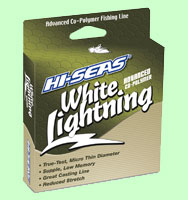 Shallow running ,clear water - 15 pound test Hi-Seas
Shallow running ,clear water - 15 pound test Hi-Seas
White Lightning- Medium running - 12 or 15 pound test Hi-Seas White Lightning
- Deep divers - 8 or 10 pound test Hi-Seas White Lightning
- Spinnerbaits - 15 or 17 pound test Hi-Seas White Lightning
- Finesse - 8 or 10 pound test Hi-Seas Black Widow
Rick's Reminders
- Faster sink rate than monofilament
- Lower stretch - increased sensitivity
- Casts further - copolymers have less fiction in the rod guides
- Decreased diameter - allows diving baits to go deeper
- Less memory - these lines do not have to be changed out as often
due to less line curling
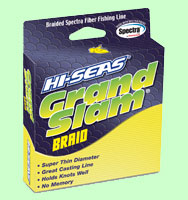 BRAIDED
LINE:
BRAIDED
LINE:
Braided lines have come a long way over the last couple of years
allowing them to be used in more applications. They have become the
workhorse of fishing lines in very dense cover. Typically, braided
lines have the largest diameter and in most case no stretch. The
zero stretch becomes very important when you choose your rod action
(this will be discussed in the next "Back to Basic's").
The most popular application for braided line is fishing dense vegetation.
Braided line cuts through the vegetation better than other types
of lines. Other applications that are becoming popular are main line
for finesse or carolina rigs and crankbaiting.
Rick's Appilcations:
- Frogs or Buzzbaits, matted grass - 50 or 65 pound test
Grand Slam Braid
- Flippin', punching grass mats or dense vegetation - 50 or 65 pound
test
Grand Slam Braid
Rick's Reminders:
- No stretch - increased sensitivity
- Rod action - extra fast tips in dense cover but moderate fast tips
with hard baits
- High visibility - the larger diameter increases the under water
visibility
- Any grass cover - these types of lines cut through grass the best
- Can be used for backing material - pre-spooling baitcasting reels
with braid can help reduce the cost of changing the entire spool
of line
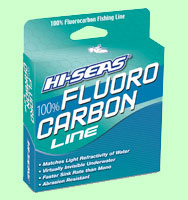 FLUOROCARBON
LINE:
FLUOROCARBON
LINE:
I saved my favorite for last. Fluorocarbon lines are the most versatile
lines on the market. With the exception of top-water applications,
they allow you to fish any bait from just below the surface to the
bottom in just about any water condition and cover. The line diameter
is typically larger than monofilament and they are denser. The denseness
of the line allows it to sink faster which hinders the performance
of top-water baits. Due to the make up of the line it becomes virtually
invisible under water. This allows it to be a top choice for finesse
fishing or used for leader material. Fluorocarbons typically have less
stretch than monofilaments which again makes the selection of your
rod action very important.
Rick's Applications:
- Carolina Rig leader - 8, 10, or 12 pound test Hi-Seas Fluorocarbon
- Jig's
- Dock's, brush - 20 or 25 pound test Hi-Seas Fluorocarbon
- Football head - 15 or 20 pound test Hi-Seas Fluorocarbon
- Finesse - 10 or 12 pound test Hi-Seas Fluorocarbon
- Texas Rig - 15 or 20 pound test Hi-Seas Fluorocarbon
- Split Shot Rig - 12 pound test Hi-Seas Fluorocarbon
- Finesse, Spot Remover - 8 pound test Hi-Seas Fluorocarbon
- Drop Shot - 6 or 8 pound test Hi-Seas Fluorocarbon
Rick's Reminders:
- Lower stretch - moderate fast tip action for hard baits
- Virtually invisible - allows higher pound test to be used
- Knot selection - I have found the Uni-Knot to work best for me
- Sinks faster - not for top-water applications
I hope you found
this month's "Back to Basic's" informative
and it helps you to increase your catch! For more information and products
offered by Hi-Seas, please visit www.hiseas.net .
If you are interested in a particular topic, visit my web
site, or
send a request to rick@ricktilson.com.
Check back next month for another informative "Back to Basic's".
Copyright© Rick
Tilson. All Rights Reserved
Images provided courtesy of Hi Seas.

